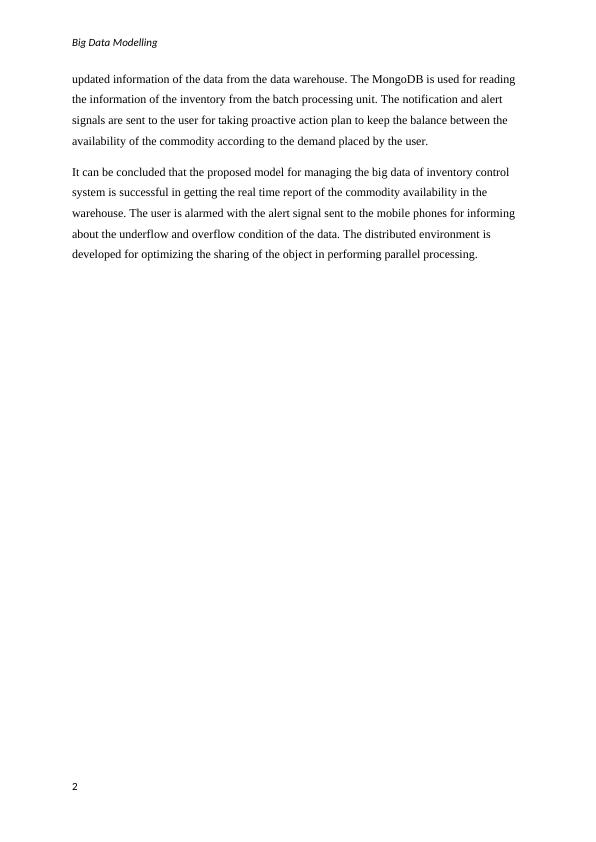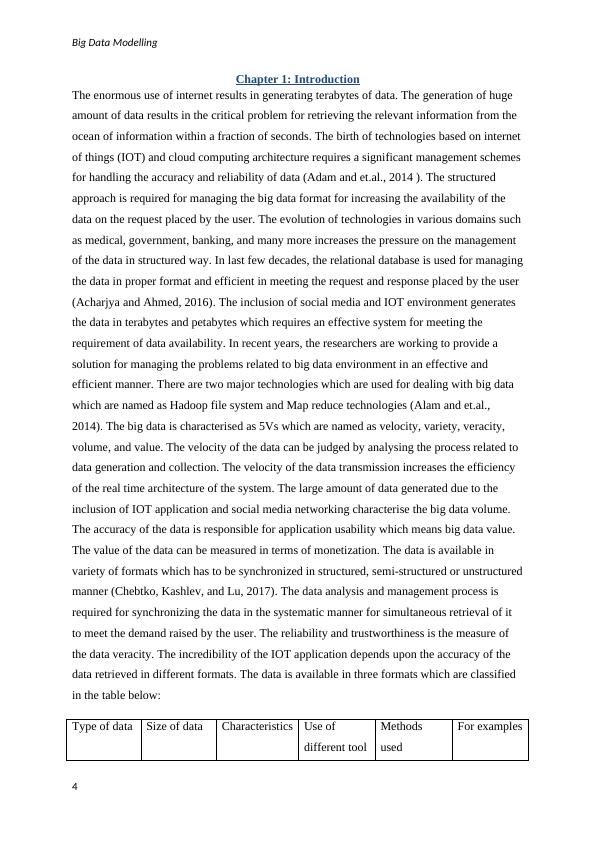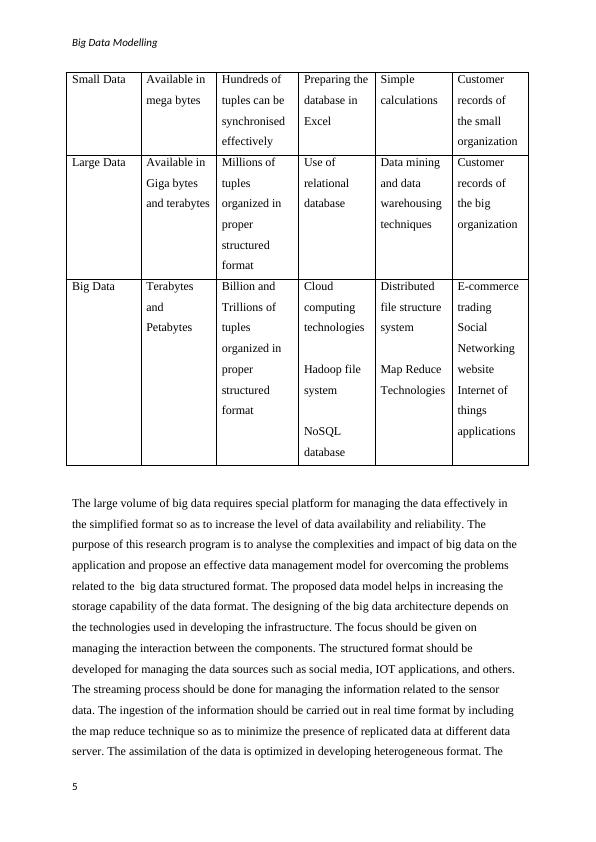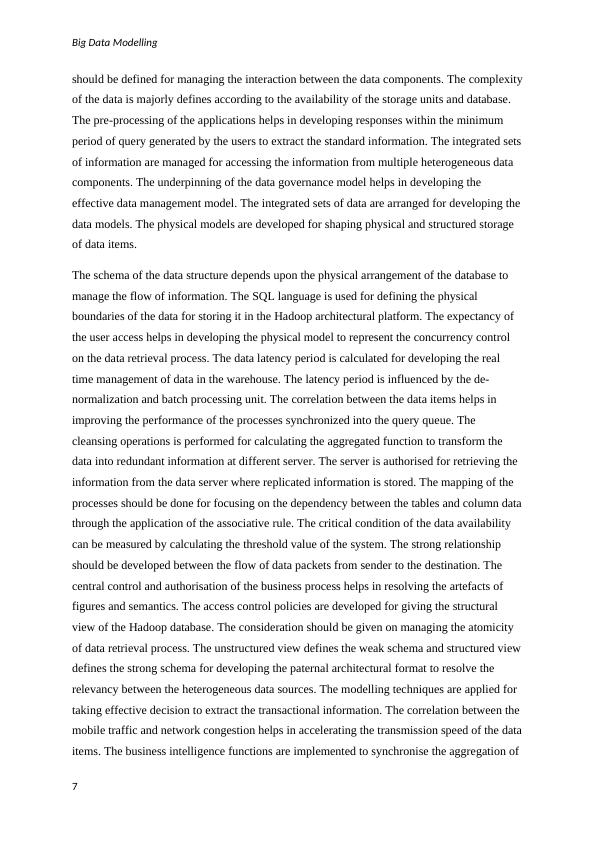Big Data Modelling
137 Pages48157 Words187 Views
Added on 2023-04-19
About This Document
This research program aims to analyze the complexities and impact of big data on applications and propose an effective data management model. It explores the challenges and trends in big data modelling and discusses techniques for handling voluminous data. The proposed model focuses on increasing storage capability and ensuring data confidentiality and reliability. The research also highlights the importance of managing data from various sources such as social media and IoT applications.
Big Data Modelling
Added on 2023-04-19
ShareRelated Documents
Big Data Modelling

Big Data Modelling
Executive Summary
In recent years, the researchers are working to provide a solution for managing the problems
related to big data environment in an effective and efficient manner. There are two major
technologies which are used for dealing with big data which are named as Hadoop file system
and Map reduce technologies. The large volume of big data requires special platform for
managing the data effectively in the simplified format so as to increase the level of data
availability and reliability. The purpose of this research program is to analyse the
complexities and impact of big data on the application and propose an effective data
management model for overcoming the problems related to the big data structured format.
The proposed data model helps in increasing the storage capability of the data format. The
designing of the big data architecture depends on the technologies used in developing the
infrastructure. The focus should be given on managing the interaction between the
components.
The aim of the research is to analyse the problems related to the management plan of big data
available due to excessive use of social networking platform and IOT applications. In this
paper, we are going to present the data modelling techniques which systematically arrange
the big data in service and infrastructure formats.
The proposed data model should be capable of handling voluminous data in a systematic
format for securing the information confidentiality, reliability, and accuracy. The
consideration should be given on the diversification of the data available from different
sources such as social networking platform, IOT architecture, and artificial intelligence. The
significance of the research study is to come up with the big data model for easy storage and
secured management of data available in large volume. The proposed architecture is the user
friendly management of inventory data to get effective results for solving the problem of big
data management. The development of the user interface provides suitability to the user to get
interactive with the features and availability of the product in the warehouse to be delivered
on time. The operations related to the inventory help in developing the interface to provide
statistics view of the data organization. It helps in finding the sales ratio to the availability of
the product in the warehouse. The implementation of the big data model proposed
architecture for managing the inventory of the organization helps the user to take proactive
action for managing and synchronizing the availability of the commodity. The danger to the
availability of the inventory can be predicted by comparing the present availability with the
threshold normal value. The Spark streaming process is used for getting the required and
1
Executive Summary
In recent years, the researchers are working to provide a solution for managing the problems
related to big data environment in an effective and efficient manner. There are two major
technologies which are used for dealing with big data which are named as Hadoop file system
and Map reduce technologies. The large volume of big data requires special platform for
managing the data effectively in the simplified format so as to increase the level of data
availability and reliability. The purpose of this research program is to analyse the
complexities and impact of big data on the application and propose an effective data
management model for overcoming the problems related to the big data structured format.
The proposed data model helps in increasing the storage capability of the data format. The
designing of the big data architecture depends on the technologies used in developing the
infrastructure. The focus should be given on managing the interaction between the
components.
The aim of the research is to analyse the problems related to the management plan of big data
available due to excessive use of social networking platform and IOT applications. In this
paper, we are going to present the data modelling techniques which systematically arrange
the big data in service and infrastructure formats.
The proposed data model should be capable of handling voluminous data in a systematic
format for securing the information confidentiality, reliability, and accuracy. The
consideration should be given on the diversification of the data available from different
sources such as social networking platform, IOT architecture, and artificial intelligence. The
significance of the research study is to come up with the big data model for easy storage and
secured management of data available in large volume. The proposed architecture is the user
friendly management of inventory data to get effective results for solving the problem of big
data management. The development of the user interface provides suitability to the user to get
interactive with the features and availability of the product in the warehouse to be delivered
on time. The operations related to the inventory help in developing the interface to provide
statistics view of the data organization. It helps in finding the sales ratio to the availability of
the product in the warehouse. The implementation of the big data model proposed
architecture for managing the inventory of the organization helps the user to take proactive
action for managing and synchronizing the availability of the commodity. The danger to the
availability of the inventory can be predicted by comparing the present availability with the
threshold normal value. The Spark streaming process is used for getting the required and
1

Big Data Modelling
updated information of the data from the data warehouse. The MongoDB is used for reading
the information of the inventory from the batch processing unit. The notification and alert
signals are sent to the user for taking proactive action plan to keep the balance between the
availability of the commodity according to the demand placed by the user.
It can be concluded that the proposed model for managing the big data of inventory control
system is successful in getting the real time report of the commodity availability in the
warehouse. The user is alarmed with the alert signal sent to the mobile phones for informing
about the underflow and overflow condition of the data. The distributed environment is
developed for optimizing the sharing of the object in performing parallel processing.
2
updated information of the data from the data warehouse. The MongoDB is used for reading
the information of the inventory from the batch processing unit. The notification and alert
signals are sent to the user for taking proactive action plan to keep the balance between the
availability of the commodity according to the demand placed by the user.
It can be concluded that the proposed model for managing the big data of inventory control
system is successful in getting the real time report of the commodity availability in the
warehouse. The user is alarmed with the alert signal sent to the mobile phones for informing
about the underflow and overflow condition of the data. The distributed environment is
developed for optimizing the sharing of the object in performing parallel processing.
2

Big Data Modelling
Contents
Executive Summary...................................................................................................................1
Chapter 1: Introduction..............................................................................................................4
Research Aim.........................................................................................................................9
Research Problem...................................................................................................................9
Research Questions..............................................................................................................10
Thesis Scope.........................................................................................................................10
Thesis Contribution..............................................................................................................11
Thesis Outline.......................................................................................................................11
Chapter 2: Literature Review...................................................................................................12
Introduction..........................................................................................................................12
Background...........................................................................................................................13
Big Data Modelling..............................................................................................................16
Tools and Technologies in relation to big data:...................................................................17
Big Data Modelling and Challenges and research issues.....................................................21
Big Data modelling progress and research trends................................................................26
Chapter 3: Research Methodology...........................................................................................56
Chapter 4: Proposed Big Data Architecture.............................................................................71
Related work:........................................................................................................................73
Proposed Architecture..........................................................................................................77
Description of the System Architecture...............................................................................84
Pre-Processing functions:.....................................................................................................94
Chapter 5: Implementation and Results.................................................................................101
Chapter 6: Conclusion............................................................................................................124
References..............................................................................................................................126
3
Contents
Executive Summary...................................................................................................................1
Chapter 1: Introduction..............................................................................................................4
Research Aim.........................................................................................................................9
Research Problem...................................................................................................................9
Research Questions..............................................................................................................10
Thesis Scope.........................................................................................................................10
Thesis Contribution..............................................................................................................11
Thesis Outline.......................................................................................................................11
Chapter 2: Literature Review...................................................................................................12
Introduction..........................................................................................................................12
Background...........................................................................................................................13
Big Data Modelling..............................................................................................................16
Tools and Technologies in relation to big data:...................................................................17
Big Data Modelling and Challenges and research issues.....................................................21
Big Data modelling progress and research trends................................................................26
Chapter 3: Research Methodology...........................................................................................56
Chapter 4: Proposed Big Data Architecture.............................................................................71
Related work:........................................................................................................................73
Proposed Architecture..........................................................................................................77
Description of the System Architecture...............................................................................84
Pre-Processing functions:.....................................................................................................94
Chapter 5: Implementation and Results.................................................................................101
Chapter 6: Conclusion............................................................................................................124
References..............................................................................................................................126
3

Big Data Modelling
Chapter 1: Introduction
The enormous use of internet results in generating terabytes of data. The generation of huge
amount of data results in the critical problem for retrieving the relevant information from the
ocean of information within a fraction of seconds. The birth of technologies based on internet
of things (IOT) and cloud computing architecture requires a significant management schemes
for handling the accuracy and reliability of data (Adam and et.al., 2014 ). The structured
approach is required for managing the big data format for increasing the availability of the
data on the request placed by the user. The evolution of technologies in various domains such
as medical, government, banking, and many more increases the pressure on the management
of the data in structured way. In last few decades, the relational database is used for managing
the data in proper format and efficient in meeting the request and response placed by the user
(Acharjya and Ahmed, 2016). The inclusion of social media and IOT environment generates
the data in terabytes and petabytes which requires an effective system for meeting the
requirement of data availability. In recent years, the researchers are working to provide a
solution for managing the problems related to big data environment in an effective and
efficient manner. There are two major technologies which are used for dealing with big data
which are named as Hadoop file system and Map reduce technologies (Alam and et.al.,
2014). The big data is characterised as 5Vs which are named as velocity, variety, veracity,
volume, and value. The velocity of the data can be judged by analysing the process related to
data generation and collection. The velocity of the data transmission increases the efficiency
of the real time architecture of the system. The large amount of data generated due to the
inclusion of IOT application and social media networking characterise the big data volume.
The accuracy of the data is responsible for application usability which means big data value.
The value of the data can be measured in terms of monetization. The data is available in
variety of formats which has to be synchronized in structured, semi-structured or unstructured
manner (Chebtko, Kashlev, and Lu, 2017). The data analysis and management process is
required for synchronizing the data in the systematic manner for simultaneous retrieval of it
to meet the demand raised by the user. The reliability and trustworthiness is the measure of
the data veracity. The incredibility of the IOT application depends upon the accuracy of the
data retrieved in different formats. The data is available in three formats which are classified
in the table below:
Type of data Size of data Characteristics Use of
different tool
Methods
used
For examples
4
Chapter 1: Introduction
The enormous use of internet results in generating terabytes of data. The generation of huge
amount of data results in the critical problem for retrieving the relevant information from the
ocean of information within a fraction of seconds. The birth of technologies based on internet
of things (IOT) and cloud computing architecture requires a significant management schemes
for handling the accuracy and reliability of data (Adam and et.al., 2014 ). The structured
approach is required for managing the big data format for increasing the availability of the
data on the request placed by the user. The evolution of technologies in various domains such
as medical, government, banking, and many more increases the pressure on the management
of the data in structured way. In last few decades, the relational database is used for managing
the data in proper format and efficient in meeting the request and response placed by the user
(Acharjya and Ahmed, 2016). The inclusion of social media and IOT environment generates
the data in terabytes and petabytes which requires an effective system for meeting the
requirement of data availability. In recent years, the researchers are working to provide a
solution for managing the problems related to big data environment in an effective and
efficient manner. There are two major technologies which are used for dealing with big data
which are named as Hadoop file system and Map reduce technologies (Alam and et.al.,
2014). The big data is characterised as 5Vs which are named as velocity, variety, veracity,
volume, and value. The velocity of the data can be judged by analysing the process related to
data generation and collection. The velocity of the data transmission increases the efficiency
of the real time architecture of the system. The large amount of data generated due to the
inclusion of IOT application and social media networking characterise the big data volume.
The accuracy of the data is responsible for application usability which means big data value.
The value of the data can be measured in terms of monetization. The data is available in
variety of formats which has to be synchronized in structured, semi-structured or unstructured
manner (Chebtko, Kashlev, and Lu, 2017). The data analysis and management process is
required for synchronizing the data in the systematic manner for simultaneous retrieval of it
to meet the demand raised by the user. The reliability and trustworthiness is the measure of
the data veracity. The incredibility of the IOT application depends upon the accuracy of the
data retrieved in different formats. The data is available in three formats which are classified
in the table below:
Type of data Size of data Characteristics Use of
different tool
Methods
used
For examples
4

Big Data Modelling
Small Data Available in
mega bytes
Hundreds of
tuples can be
synchronised
effectively
Preparing the
database in
Excel
Simple
calculations
Customer
records of
the small
organization
Large Data Available in
Giga bytes
and terabytes
Millions of
tuples
organized in
proper
structured
format
Use of
relational
database
Data mining
and data
warehousing
techniques
Customer
records of
the big
organization
Big Data Terabytes
and
Petabytes
Billion and
Trillions of
tuples
organized in
proper
structured
format
Cloud
computing
technologies
Hadoop file
system
NoSQL
database
Distributed
file structure
system
Map Reduce
Technologies
E-commerce
trading
Social
Networking
website
Internet of
things
applications
The large volume of big data requires special platform for managing the data effectively in
the simplified format so as to increase the level of data availability and reliability. The
purpose of this research program is to analyse the complexities and impact of big data on the
application and propose an effective data management model for overcoming the problems
related to the big data structured format. The proposed data model helps in increasing the
storage capability of the data format. The designing of the big data architecture depends on
the technologies used in developing the infrastructure. The focus should be given on
managing the interaction between the components. The structured format should be
developed for managing the data sources such as social media, IOT applications, and others.
The streaming process should be done for managing the information related to the sensor
data. The ingestion of the information should be carried out in real time format by including
the map reduce technique so as to minimize the presence of replicated data at different data
server. The assimilation of the data is optimized in developing heterogeneous format. The
5
Small Data Available in
mega bytes
Hundreds of
tuples can be
synchronised
effectively
Preparing the
database in
Excel
Simple
calculations
Customer
records of
the small
organization
Large Data Available in
Giga bytes
and terabytes
Millions of
tuples
organized in
proper
structured
format
Use of
relational
database
Data mining
and data
warehousing
techniques
Customer
records of
the big
organization
Big Data Terabytes
and
Petabytes
Billion and
Trillions of
tuples
organized in
proper
structured
format
Cloud
computing
technologies
Hadoop file
system
NoSQL
database
Distributed
file structure
system
Map Reduce
Technologies
E-commerce
trading
Social
Networking
website
Internet of
things
applications
The large volume of big data requires special platform for managing the data effectively in
the simplified format so as to increase the level of data availability and reliability. The
purpose of this research program is to analyse the complexities and impact of big data on the
application and propose an effective data management model for overcoming the problems
related to the big data structured format. The proposed data model helps in increasing the
storage capability of the data format. The designing of the big data architecture depends on
the technologies used in developing the infrastructure. The focus should be given on
managing the interaction between the components. The structured format should be
developed for managing the data sources such as social media, IOT applications, and others.
The streaming process should be done for managing the information related to the sensor
data. The ingestion of the information should be carried out in real time format by including
the map reduce technique so as to minimize the presence of replicated data at different data
server. The assimilation of the data is optimized in developing heterogeneous format. The
5

Big Data Modelling
operational efficiency of the big data architecture can be accelerated by developing the
master data management plan. The real time analysis of the data helps in getting the updated
version of the information. The functional and operational view of the data can be increased
by emerging the landing repositories of the information. The exploration of the data is formed
by organizing the data sets and blocks of information for getting the required information
with minimum period of time. The security and confidentiality of the information are two
major issues related to the data privacy of the heterogeneous data. The big data models results
in increasing the key performance indicators of the developed application. The hierarchical
taxonomy is prepared for developing the structured ontological structured format. The
synchronization of different and hybrid technologies together in a single format help in
developing the effective design model to get required information. The atomicity of the
information can be achieved by implementing the normalization techniques. The data models
designs are influenced by the schema formation and integration of different components. The
Hadoop model is used for storing the sensor data of the IOT application at distributed servers.
The correlation between the components helps in minimizing the latency time for retrieving
the updated information. The aggregation of the information helps in managing the
governance of the data. The database schema should be designed for forming the
visualization of data at distributed server. The information is stored systematically in
RDBMS for implementing the business intelligence operations on the working model of the
warehouse. The interaction between the components helps in preserving the well-structured
format to manage the internal sources data by streamlining the sensor data and devices. The
information is assimilated from various sources to give the real time situation and availability
of the data in the warehouse. The information can be timely retrieve through the streaming
process and inclusion of map reduce technology. The operational efficiency of the big data
can be improved by developing the master data management system. It focuses on managing
the operational data stores for improving the power of computation and procedure. The big
data architecture is developed for synchronizing the data patterns according to the data
collected from real time sensor devices. The information is stored in repositories of large
chunks of memory for systematic approach of real time data from the heterogeneous sources.
The activities are systematically sequenced for exposure of supporting functions and
operational working process. The data is governed by exploration of security architecture and
metadata formation. The advanced technology is defined for developing the structured
architecture of the data sets. The conceptual model should be developed by following the
semantics and symbols of data to prepare the data nodes. The consistency of the data items
6
operational efficiency of the big data architecture can be accelerated by developing the
master data management plan. The real time analysis of the data helps in getting the updated
version of the information. The functional and operational view of the data can be increased
by emerging the landing repositories of the information. The exploration of the data is formed
by organizing the data sets and blocks of information for getting the required information
with minimum period of time. The security and confidentiality of the information are two
major issues related to the data privacy of the heterogeneous data. The big data models results
in increasing the key performance indicators of the developed application. The hierarchical
taxonomy is prepared for developing the structured ontological structured format. The
synchronization of different and hybrid technologies together in a single format help in
developing the effective design model to get required information. The atomicity of the
information can be achieved by implementing the normalization techniques. The data models
designs are influenced by the schema formation and integration of different components. The
Hadoop model is used for storing the sensor data of the IOT application at distributed servers.
The correlation between the components helps in minimizing the latency time for retrieving
the updated information. The aggregation of the information helps in managing the
governance of the data. The database schema should be designed for forming the
visualization of data at distributed server. The information is stored systematically in
RDBMS for implementing the business intelligence operations on the working model of the
warehouse. The interaction between the components helps in preserving the well-structured
format to manage the internal sources data by streamlining the sensor data and devices. The
information is assimilated from various sources to give the real time situation and availability
of the data in the warehouse. The information can be timely retrieve through the streaming
process and inclusion of map reduce technology. The operational efficiency of the big data
can be improved by developing the master data management system. It focuses on managing
the operational data stores for improving the power of computation and procedure. The big
data architecture is developed for synchronizing the data patterns according to the data
collected from real time sensor devices. The information is stored in repositories of large
chunks of memory for systematic approach of real time data from the heterogeneous sources.
The activities are systematically sequenced for exposure of supporting functions and
operational working process. The data is governed by exploration of security architecture and
metadata formation. The advanced technology is defined for developing the structured
architecture of the data sets. The conceptual model should be developed by following the
semantics and symbols of data to prepare the data nodes. The consistency of the data items
6

Big Data Modelling
should be defined for managing the interaction between the data components. The complexity
of the data is majorly defines according to the availability of the storage units and database.
The pre-processing of the applications helps in developing responses within the minimum
period of query generated by the users to extract the standard information. The integrated sets
of information are managed for accessing the information from multiple heterogeneous data
components. The underpinning of the data governance model helps in developing the
effective data management model. The integrated sets of data are arranged for developing the
data models. The physical models are developed for shaping physical and structured storage
of data items.
The schema of the data structure depends upon the physical arrangement of the database to
manage the flow of information. The SQL language is used for defining the physical
boundaries of the data for storing it in the Hadoop architectural platform. The expectancy of
the user access helps in developing the physical model to represent the concurrency control
on the data retrieval process. The data latency period is calculated for developing the real
time management of data in the warehouse. The latency period is influenced by the de-
normalization and batch processing unit. The correlation between the data items helps in
improving the performance of the processes synchronized into the query queue. The
cleansing operations is performed for calculating the aggregated function to transform the
data into redundant information at different server. The server is authorised for retrieving the
information from the data server where replicated information is stored. The mapping of the
processes should be done for focusing on the dependency between the tables and column data
through the application of the associative rule. The critical condition of the data availability
can be measured by calculating the threshold value of the system. The strong relationship
should be developed between the flow of data packets from sender to the destination. The
central control and authorisation of the business process helps in resolving the artefacts of
figures and semantics. The access control policies are developed for giving the structural
view of the Hadoop database. The consideration should be given on managing the atomicity
of data retrieval process. The unstructured view defines the weak schema and structured view
defines the strong schema for developing the paternal architectural format to resolve the
relevancy between the heterogeneous data sources. The modelling techniques are applied for
taking effective decision to extract the transactional information. The correlation between the
mobile traffic and network congestion helps in accelerating the transmission speed of the data
items. The business intelligence functions are implemented to synchronise the aggregation of
7
should be defined for managing the interaction between the data components. The complexity
of the data is majorly defines according to the availability of the storage units and database.
The pre-processing of the applications helps in developing responses within the minimum
period of query generated by the users to extract the standard information. The integrated sets
of information are managed for accessing the information from multiple heterogeneous data
components. The underpinning of the data governance model helps in developing the
effective data management model. The integrated sets of data are arranged for developing the
data models. The physical models are developed for shaping physical and structured storage
of data items.
The schema of the data structure depends upon the physical arrangement of the database to
manage the flow of information. The SQL language is used for defining the physical
boundaries of the data for storing it in the Hadoop architectural platform. The expectancy of
the user access helps in developing the physical model to represent the concurrency control
on the data retrieval process. The data latency period is calculated for developing the real
time management of data in the warehouse. The latency period is influenced by the de-
normalization and batch processing unit. The correlation between the data items helps in
improving the performance of the processes synchronized into the query queue. The
cleansing operations is performed for calculating the aggregated function to transform the
data into redundant information at different server. The server is authorised for retrieving the
information from the data server where replicated information is stored. The mapping of the
processes should be done for focusing on the dependency between the tables and column data
through the application of the associative rule. The critical condition of the data availability
can be measured by calculating the threshold value of the system. The strong relationship
should be developed between the flow of data packets from sender to the destination. The
central control and authorisation of the business process helps in resolving the artefacts of
figures and semantics. The access control policies are developed for giving the structural
view of the Hadoop database. The consideration should be given on managing the atomicity
of data retrieval process. The unstructured view defines the weak schema and structured view
defines the strong schema for developing the paternal architectural format to resolve the
relevancy between the heterogeneous data sources. The modelling techniques are applied for
taking effective decision to extract the transactional information. The correlation between the
mobile traffic and network congestion helps in accelerating the transmission speed of the data
items. The business intelligence functions are implemented to synchronise the aggregation of
7

End of preview
Want to access all the pages? Upload your documents or become a member.
Related Documents
Infrastructure of Big Datalg...
|10
|2975
|421
Internet of Things: Privacy Issues and Contentslg...
|9
|1402
|116
Business Process Modelling for Inshore Insurance Ltdlg...
|16
|2713
|137
Development of Cloud Computing - PDFlg...
|15
|4861
|117
Emerging Technologies and Innovationlg...
|15
|3034
|134
Types of Cloud Computing Architecture - PDFlg...
|11
|1546
|242
